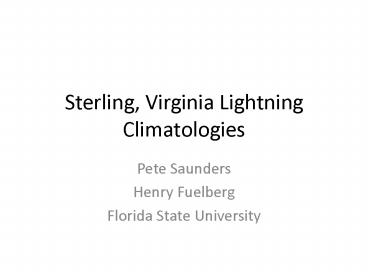Sterling, Virginia Lightning Climatologies - PowerPoint PPT Presentation
1 / 20
Title:
Sterling, Virginia Lightning Climatologies
Description:
The following graphs depict the total flash counts versus the time they occur. ... I am looking forward to hearing your opinions on the general convective nature ... – PowerPoint PPT presentation
Number of Views:66
Avg rating:3.0/5.0
Title: Sterling, Virginia Lightning Climatologies
1
Sterling, Virginia Lightning Climatologies
- Pete Saunders
- Henry Fuelberg
- Florida State University
2
Time Series
- The following graphs depict the total flash
counts versus the time they occur. The times
have been converted from UTC to Eastern Standard
Time (EST). The first graph, entitled Warm
Season Hourly Counts gives a seasonal
representation of the time in which most
lightning flashes occur in the Sterling NWS area
of interest. The subsequent graphs are a month by
month illustration. - The warm season indicates the months of
April through September over an 11 year period.
Finally, the area represented in the plots is
between - Latitude 36.5 N through 42.1 N
- Longitude -74.0 W through -80.5 W
- Please note The ordinate axes of the
following graphs are not to scale
3
(No Transcript)
4
(No Transcript)
5
(No Transcript)
6
(No Transcript)
7
(No Transcript)
8
(No Transcript)
9
(No Transcript)
10
(No Transcript)
11
Remarks
- Examining lightning counts temporally
illustrates the convective nature of the
atmosphere climatologically throughout the warm
season. - As might be expected, the total flash counts
for April are similar to those for September.
The large jumps from April to May to June are
interesting to note as well. - July stands out as the month with the highest
flash counts followed by a rather sharp decrease
of about 10 000 flashes in August.
12
Spatial Density Maps
- The following maps depict the spatial
densities of CG lightning flashes for the
Sterling, Virginia research region. The first
map, entitled Warm Season Flash Density, gives
a seasonal representation of the areas with the
highest density of CG lightning strikes for the
entire warm season. The subsequent maps are a
month by month representation of lightning
density. - Please Note
- The coordinates for the density maps are the
same as previously mentioned with regards to the
time series. - Lightning densities do not follow the same
scale on each map.
13
Low relative densities throughout the Delmarva
Peninsula
Interesting region of relatively high densities
in western P.G. County
Low densities in the mountain/valley regions of
VA and WVA
Region of highest lightning densities
14
Interesting pocket of relatively high density in
Baltimores southern suburbs (Anne Arundel County)
15
(No Transcript)
16
Highest June densities occur in eastern and
northwestern suburbs of Washington, D.C. (P.G.
County and Loudoun County respectively)
17
Very high densities in Norfolk, VA region
18
(No Transcript)
19
(No Transcript)
20
Remarks
- Southeastern Virginia has, by far, the largest
area of high CG lightning flash densities. - -We believe this is due to topographical
effects which include but are not limited to a
sea-breeze effect from the mouth of the
Chesapeake Bay and the Atlantic Ocean along with
the blocking of moisture by the Appalachian
Mountains generally resulting in convergence. I
would appreciate any input to confirm or deny
this speculation. - There are some hot spots in the D.C. and
Baltimore suburbs that would be interesting to
examine further. - Overall, there appear to many micro climes
in this region. I am looking forward to hearing
your opinions on the general convective nature in
this region during the warm season months. Any
input/suggestions/explanations for the location
of the highest and lowest lightning densities
would be greatly appreciated. - Also, please share this document with your
forecasters in order to facilitate feedback and
understanding.































